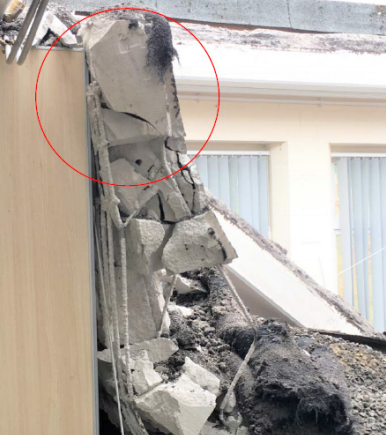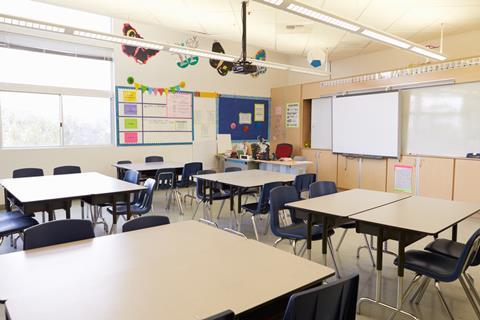║├╔½Ž╚╔·TV has been writing about concerns about the conditions of schools long before the RAAC crisis hit the spotlight. Here we republish a piece we published on the need for refurbishment back in July.


Piece republished on 4 September
There have been rumblings for some time. In 2018 the roof of a primary school in Kent collapsed. In 2022, a government report admitted there was a ŌĆ£very likelyŌĆØ risk of further collapses in some schools built using lightweight materials. In February this year, seven education unions wrote to the government demanding urgent action, describing the reportŌĆÖs findings as ŌĆ£truly shockingŌĆØ.
Now the National Audit Office has revealed there are an estimated 700,000 pupils learning in buildings which the Department of Education (DfE) believes require major rebuilding or major refurbishment. An astonishing 38% of EnglandŌĆÖs 64,000 buildings have now passed their estimated design life, the NAOŌĆÖs report found.
If the government had to choose one type of public sector building which needs to be structurally sound, you would think schools would be pretty high up that list. Despite all of the disruptive events politicians have been faced with over the last decade, whether its public debt, Brexit, the pandemic or inflation, you would hope the safety of children had not fallen down the governmentŌĆÖs list of priorities. Sadly, this appears to be far from the case.
In 2020, the DfE recommended a minimum annual spend of ┬Ż5.3bn to ensure the long-term maintenance of school buildings. The actual average yearly spend between 2016-2017 and 2022-2023 was less than half of this, ┬Ż2.3bn. The DfEŌĆÖs recommended funding would also include mitigating the ŌĆ£most serious risks of building failureŌĆØ, such as those found to contain reinforced autoclaved aerated concrete (RAAC), a cheap material mostly used in system build programmes from the 1950s to the 1980s but which has now passed its 30-year design life.

The department does have its school rebuilding programme, which aims to rebuild or repair 500 schools over the next decade. Launched in summer 2020, it has so far seen the completion of only one project. The DfEŌĆÖs own forecast had predicted four schemes would be completed by now. Worryingly, the department had also only awarded 24 contracts by March 2023, a third of the 84 it had expected to sign by that date.
Safety concerns
Meanwhile, schools built decades ago, including 10,000 buildings dating to before 1940, are continuing to deteriorate, putting the safety of children more at risk as each day passes. The 2018 school roof collapse, at Singlewell Primary School in Gravesend, luckily resulted in no injuries as it happened over the weekend. But it had also collapsed almost without warning - the first signs of structural stress were noticed only the previous evening.
It goes without saying that a much more serious outcome in the near term is more than possible - in the governmentŌĆÖs own 2022 assessment another collapse is highly likely. The DfE has allocated ┬Ż6m for around 600 investigations of school buildings thought to contain RAAC, giving an idea of the numbers of buildings at risk. As of May this year, the department had completed 196 assessments, confirming the presence of RAAC in 65 buildings, 24 of which required immediate attention. The same month, the department said it would provide funding to ensure these blocks do not pose an immediate risk.
Another legacy of system-build schools is asbestos, which was widely used during roughly the same era as RAAC, from the 1950s to the mid-1980s, although any school built before 2000 may contain it. The material is safe if correctly maintained, but can release fibres when disturbed which can cause serious diseases. These include mesothelioma, a cancer of the lining of the internal organs which often causes no significant symptoms until it is at an advanced stage, and incurable.
The DfE started surveying schools for asbestos in 2018. By March 2023, 93% of schools had responded and more than 80% had identified asbestos, including 97% of system builds. Maintaining the material can be more difficult in buildings that are deteriorating or require repair work, because of the risk of disturbance, and its presence can also significantly increase the cost of refurbishments.
Delays to the school rebuilding programme
But what about the wider problem with the condition of school buildings? The DfE has said it has specific concerns about an estimated 3,600 system built school buildings which are believed to be susceptible to deterioration. While it has approved plans for invasive structural assessments in 200 schools, it is yet to procure specialists to carry out the first 100 visits.
While the government does, belatedly, appear to be giving bandwidth to the issue now, it is facing issues with procurement that are holding back delivery of the required work. Reasons given for the slow progress in awarding contracts under the school rebuilding programme include suppliers not taking up contracts because of instability in the construction sector and inflationary risks, according to the NAO.
School numbers: the NAO report at a glance
- In England the school estate is made up of 64,000 individual buildings and there are 21,600 state schools educating 8.4 million children
- 3,600 system-built blocks which the DfE believes are at risk of deterioration
- 38% of school buildings are believed to be past their estimated design life
- ┬Ż5.3bn: annual funding recommended by DfE for long-term school maintenance
- ┬Ż2.3bn: actual average DfE capital funding for school rebuilding, maintenance and repair spent by DfE between 2016-17 and 2022-23
- 700,000 pupils are learning in buildings which the DfE believes require major rebuilding or refurbishment
- 500 schools deemed to be in the most urgent need are due to be rebuilt or refurbished under the DfEŌĆÖs school rebuilding programme
- 15% of eligible schools made no applications for maintenance and repair funding between 2016-17 and 2022-23
- 572 schools have been identified as possibly containing reinforced autoclaved aerated concrete (RAAC)
- RAAC has been confirmed in 65 schools, with 24 requiring immediate action
Source:
Alan Jarvie is a director at Atkins and the firmŌĆÖs UK education sector lead. He has worked at the firm for 33 years, almost all of that time on the school estate, both on the client side and for contractors. He describes the issues now facing the maintenance of the school estate in England as a ŌĆ£perfect stormŌĆØ of inflation, post-Brexit labour constraints and post-Grenfell regulatory constraints.
While the volume of school work is high, the margins for contractors are much lower than other sectors. This is compounded by restricted budgets - the Treasury allocated the DfE ┬Ż3.1bn a year to maintain schools between 2021 and 2025, and as already mentioned, it has been spending less than that. Jarvie says contractors have been seeing a lot of their tenders rejected because the department had aimed too low on its budgets for schemes or not taken account of inflation.
In his experience, contractors working in education spend a lot of time looking at schemes to check if the budgets stack up, and find that they donŌĆÖt. ŌĆ£TheyŌĆÖre at ┬Ż30m, for example, and our contractors and our cost managers are pricing at ┬Ż45m, is that a scheme thatŌĆÖs worth investing time into?
Are [contractors] going to invest time in bidding, only to find that it will go on hold, or thereŌĆÖs a big value engineering exercise to get it back down
Alan Jarvie, Atkins
ŌĆ£Because bidding these sorts of things are expensive. Are we going to invest time in bidding, only to find that it will go on hold, or thereŌĆÖs a big value engineering exercise to get it back down?ŌĆØ
Craig Shanley, head of education at McLaren Construction, says inflation and material shortages caused by the war in Ukraine over the past year have ŌĆ£challenged decision-making processes that were already complicatedŌĆØ. The cost of living crisis has further intensified the debate about who and where public money is spent, trapping some schools in a ŌĆ£loop of never-ending maintenanceŌĆØ rather than the comprehensive rebuild they need, he says.
The NAO reportŌĆÖs findings have come as no surprise, says NVB Architects landscape director Peter Baker. He has seen first hand schools patching up decades-old ŌĆśtemporaryŌĆÖ demountable huts while awaiting funding. When rebuilds ore refurbishments are approved, he says maintenance is sometimes postponed as much as possible to save money. But this period often extends for years, worsening the appearance of neglect.
ŌĆ£The issue is given a real sense of urgency when we speak to the teachers and school leaders who tell us what the conditions are like and how this lasts for years, impacting on learning and lives,ŌĆØ he says.
ŌĆ£There are teachers providing children with wonderful teaching, in spite of the inadequate surroundings, who could achieve even more with the right facilities. Classrooms are often too cold in winter and too hot in summer due to poor windows, insulation and ventilation. Modern technology is often problematic to use with glare on interactive teaching screens or ŌĆśsmart-boardsŌĆÖ and screens on all the other devices we depend on now caused by difficulty in controlling light. The condition of toilets, stairs and corridors, intrinsic parts of day-to-day experiences are often tired and unpleasant.ŌĆØ
There are teachers providing children with wonderful teaching, in spite of the inadequate surroundings, who could achieve even more with the right facilities
Peter Baker, NVB Architects
During delays in getting schemes to an affordable budget, contractors often start looking at jobs in better funded public sectors such as defence. ŌĆ£We canŌĆÖt do it all, so firms are picking the ones that are maybe going to come through, that are maybe less risky,ŌĆØ Jarvie says. ŌĆ£I think thatŌĆÖs part of the reason why it hasnŌĆÖt moved as well as it should have.ŌĆØ Of around 40 schemes which Atkins is working on, only five have gone to site.

Access to funding
The years of austerity in public funding following the 2008 financial crisis has also had an impact on the DfEŌĆÖs capacity to address the school estate. Teams have been slimmed down and there has been a high turnover of staff, something which Jarvie says has hampered how some of the funding for schemes is allocated.
The way schools receive funding has also been complicated by the fragmentation of the schools estate, which was radically reformed in 2010 when then education secretary Michael Gove allowed schools to opt out of local authority control by converting to academy status. School academy trusts with a combined number of pupils under 3,000 have to go through annual rounds of bidding for condition improvement funding, which pits schools against each other for the same limited funding pool. Those that do secure funding are often the academy trusts with resources to put together good bids. Consequently, the schools most in need are often overlooked because their bids are less polished.
All of this points to systemic issues for the school estate in England, and these issues have been worsened by global trends such as inflation just as the condition of school buildings risks entering a critical state. Meanwhile, the maintenance of schools in other parts of the UK has been arguably more successful. In Wales, it is driven by local authorities, which take an active ownership of the work in prioritising schools and making sure the money goes to the places most in need. By setting realistic budgets, Jarvie at Atkins argues local authorities in Wales have developed a mature delivery model using frameworks with a limited number of specialist contractors and local supply chain firms. It has given Welsh contractors a guaranteed pipeline.
ŌĆ£There is an expertise being built up by the supply chain that knows how to deliver schools,ŌĆØ says Jarvie. ŌĆ£There is almost a bit more of a maturity and a rhythm of how this stuff works.ŌĆØ
The Department of Education has no plan for reducing carbon emissions from the English school estate
A second was published at the same time as its report on the condition of school buildings. It found the DfEŌĆÖs efforts to improve the energy efficiency of schools is being hampered by a ŌĆ£lack of a clear, national picture of the sustainability position of schools or the risk that climate change posesŌĆØ.
The report also found that the DfE has no real plan for how the estate will play its part in achieving the governmentŌĆÖs net zero targets. The government had committed to reducing emissions from public sector building by 75% by 2037, and the DfE is currently responsible for more than a third of those emissions. The department has not set its own target for reducing them, and the NAO concluded that the current school rebuilding programme will ŌĆ£not bring it closeŌĆØ to achieving the wider government target.
The NAO has recommended the department consider how its sustainability ambitions can be achieved when addressing the condition of the school estate. It also recommends improving the data and evidence base for sustainability measures and setting out a decarbonisation plan for the sector.
Making a case the value for money case
So what is the solution for England now? RIBA president Simon Allford says the government has ŌĆ£simply not put enough money in the pot to address the scale of the problemŌĆØ. But a major uplift in funding is a hard call for Rishi Sunak given the squeeze faced by the Treasury, regardless of the need. The prime minister has firmly resisted calls to increase government borrowing to fund things like public sector pay rises because of the risk of causing inflation. School maintenance is also just one of many urgent issues in the public estate requiring urgent attention, not least the maintenance backlog in the NHS, which was valued at ┬Ż10.2bn in 2021/22, an increase of 11% on 2020/21.
But Baker argues bringing about a transformation in school facilities does not require extravagant budgets or trophy architecture. What it does need is a ŌĆ£combination of realistic funding and creative thinking,ŌĆØ he says. ŌĆ£Often wholesale demolition is unnecessary and undesirable from a sustainability perspective and creative reuse is all that is required.ŌĆØ
The NAO report found that current funding levels could be forcing some schools to delay carrying out remedial work, leading to poor value for money in the long term. DfE analysis has found that the modelled cost to return buildings to a good standard of repair increased by 9%, from ┬Ż133 per sq m in 2012-2014 to ┬Ż145 per sq m in 2017-2019. The NAO has called on the department to ensure its approach provides the best value from the resources it currently has available.
Against the odds, the government has now relaunched the New Hospital Programme with ┬Ż20bn of funding. It will use modern methods of construction to build at least 14 of the new hospitals, with the approach aiming to reduce cost and delivery time by around 25%. The use of MMC was partly informed by two sandpit projects at the Manufacturing Technology Centre (MTC) in Coventry, which were visited by ministers and officials from several government departments. One of the projects was a small health unit; the other was an education block. Teams at the MTC claimed scaling up the modular approach used for the education scheme could see a full size school built in under six weeks.
The parallels with the problems caused by system build programmes in the 1960s and 70s, including the use of RAAC and other unsafe materials such as asbestos, are potentially troubling. The MMC sector is also notoriously unstable - only last month modular housebuilder Ilke Homes collapsed with the loss of more than 1,000 jobs. But if the DfE gets it right, MMC could offer a solution which would make it possible to not only build schools faster but, with the use of standardised components, make them much cheaper to maintain in the long-term.
A Department for Education spokesperson said:
ŌĆ£Nothing is more important than the safety of pupils and teachers which is why we have been significantly investing in transforming schools up and down the country .
ŌĆ£We are investing in 500 projects for new and refurbished school buildings through our School Rebuilding Programme. On top of this, we have allocated over ┬Ż15 billion since 2015 for keeping schools safe and operational, including ┬Ż1.8 billion committed for 2023-24.
ŌĆ£It is the responsibility of those who run our schools ŌĆō academy trusts, local authorities, and voluntary-aided school bodies ŌĆō who speak to their schoolsŌĆÖ day to day to manage the maintenance of their schools and to alert us if there is a concern with a building. We will always provide support on a case-by-case basis if we are alerted to a serious safety issue by these responsible bodies.ŌĆØ
That may be a few years off - the New Hospital Programme only committed to the approach this year, three years after the programme was launched - but it offers a potential way forward. Meanwhile there are hundreds of school rebuild and refurbishment schemes waiting to get off the ground, and an industry looking for viable work. Jarvie says: ŌĆ£YouŌĆÖve got a maturity in our sector. LetŌĆÖs try and put the plan together and target what needs to be done. ThereŌĆÖs a willingness to get this started.ŌĆØ
Join us at the ║├╔½Ž╚╔·TV the Future Commission Conference

You can join the in Westminster on 27 September to hear from leading figures across the construction industry and find out more about the work of the commission.
The day will include panel debates on net zero, digital transformation and building safety as well as talks from high-profile keynote speakers on future trends and ideas that could transform the sector.
There will also be the chance to feed in your ideas to the commission and to network with other industry professionals keen to share knowledge.
You can follow our progress using #║├╔½Ž╚╔·TVTheFuture on social media.
About the commission
The ║├╔½Ž╚╔·TV the Future Commission is a 12-month project looking at radical and challenging ideas that could help transform the built environment.
The campaign aims to tap into innovative ideas, amplify them and be an agent for change.
The major projectŌĆÖs work will be guided by a panel of major figures who have signed up to help shape the commissionŌĆÖs work culminating in a report published at the end of the year.
The commissioners include figures from the world of contracting, housing development, architecture, policy-making, skills, design, place-making, infrastructure, consultancy and legal. See the full list here.
The project is looking at proposals for change in eight areas:
- Education and skills
- Housing and planning
- Energy and net zero
- Infrastructure
- ║├╔½Ž╚╔·TV safety
- Project delivery and digital
- Workplace culture and leadership
- Creating communities
>> EditorŌĆÖs view: And now for something completely positive - our ║├╔½Ž╚╔·TV the Future Commission
>> Click here for more about the project and the commissioners
║├╔½Ž╚╔·TV the Future is also undertaking a countrywide tour of roundtable discussions with experts around the regions as part of a consultation programme in partnership with the regional arms of industry body Constructing Excellence. There is also a young personŌĆÖs advisory panel.



























1 Readers' comment